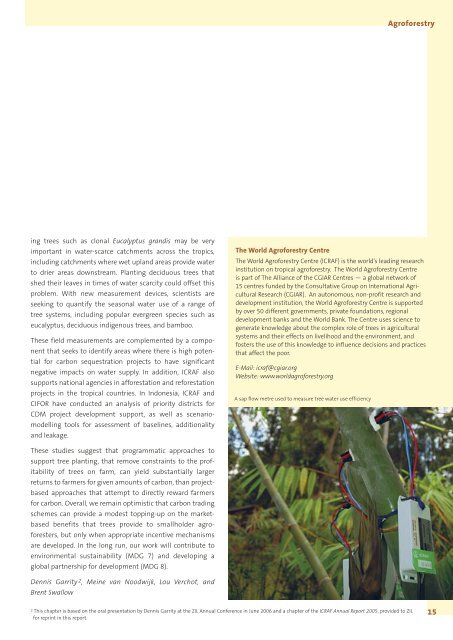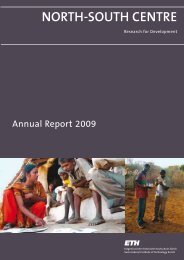Annual Report 2006/07 - ETH - North-South Centre North-South ...
Annual Report 2006/07 - ETH - North-South Centre North-South ...
Annual Report 2006/07 - ETH - North-South Centre North-South ...
Create successful ePaper yourself
Turn your PDF publications into a flip-book with our unique Google optimized e-Paper software.
Agroforestrying trees such as clonal Eucalyptus grandis may be veryimportant in water-scarce catchments across the tropics,including catchments where wet upland areas provide waterto drier areas downstream. Planting deciduous trees thatshed their leaves in times of water scarcity could offset thisproblem. With new measurement devices, scientists areseeking to quantify the seasonal water use of a range oftree systems, including popular evergreen species such aseucalyptus, deciduous indigenous trees, and bamboo.These field measurements are complemented by a componentthat seeks to identify areas where there is high potentialfor carbon sequestration projects to have significantnegative impacts on water supply. In addition, ICRAF alsosupports national agencies in afforestation and reforestationprojects in the tropical countries. In Indonesia, ICRAF andCIFOR have conducted an analysis of priority districts forCDM project development support, as well as scenariomodellingtools for assessment of baselines, additionalityand leakage.The World Agroforestry <strong>Centre</strong>The World Agroforestry <strong>Centre</strong> (ICRAF) is the world’s leading researchinstitution on tropical agroforestry. The World Agroforestry <strong>Centre</strong>is part of The Alliance of the CGIAR <strong>Centre</strong>s — a global network of15 centres funded by the Consultative Group on International AgriculturalResearch (CGIAR). An autonomous, non-profit research anddevelopment institution, the World Agroforestry <strong>Centre</strong> is supportedby over 50 different governments, private foundations, regionaldevelopment banks and the World Bank. The <strong>Centre</strong> uses science togenerate knowledge about the complex role of trees in agriculturalsystems and their effects on livelihood and the environment, andfosters the use of this knowledge to influence decisions and practicesthat affect the poor.E-Mail: icraf@cgiar.orgWebsite: www.worldagroforestry.orgA sap flow metre used to measure tree water use efficiencyThese studies suggest that programmatic approaches tosupport tree planting, that remove constraints to the profitabilityof trees on farm, can yield substantially largerreturns to farmers for given amounts of carbon, than projectbasedapproaches that attempt to directly reward farmersfor carbon. Overall, we remain optimistic that carbon tradingschemes can provide a modest topping-up on the marketbasedbenefits that trees provide to smallholder agroforesters,but only when appropriate incentive mechanismsare developed. In the long run, our work will contribute toenvironmental sustainability (MDG 7) and developing aglobal partnership for development (MDG 8).Dennis Garrity 2 , Meine van Noodwijk, Lou Verchot, andBrent Swallow2 This chapter is based on the oral presentation by Dennis Garrity at the ZIL <strong>Annual</strong> Conference in June <strong>2006</strong> and a chapter of the ICRAF <strong>Annual</strong> <strong>Report</strong> 2005, provided to ZILfor reprint in this report.15
















